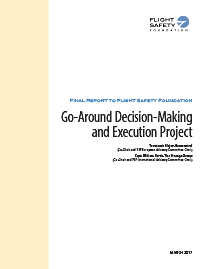Go-Around Decision-Making and Execution Project
Failure to conduct a go-around is the number one risk factor in approach and landing accidents and a primary cause  of runway excursions. The global aviation industry’s rate of compliance with go-around policies is extremely poor: Approximately 3 percent of unstable approaches result in go-around policy compliance. Improving compliance holds tremendous potential in reducing approach and landing accidents. The go-around itself is not without risk, however, and must be understood before more go-arounds are encouraged and performed.
of runway excursions. The global aviation industry’s rate of compliance with go-around policies is extremely poor: Approximately 3 percent of unstable approaches result in go-around policy compliance. Improving compliance holds tremendous potential in reducing approach and landing accidents. The go-around itself is not without risk, however, and must be understood before more go-arounds are encouraged and performed.
The Flight Safety Foundation Go-Around Decision-Making and Execution Project was launched in 2011 to research and answer the question “Why are we so poor at complying with established go-around policies?” It was also intended to improve our understanding of the risks associated with executing go-arounds and to make recommendations to improve compliance and mitigate risks associated with the go-around maneuver itself.
The final report on the Foundation’s Go-Around Decision Making and Execution Project now is available.
Podcast Interview
Greg Marshall, the Foundation’s vice president, global programs, and Capt. Bill Curtis, one of the co-authors of the report,
discuss the report and what it means for the industry in our latest podcast. Click here to access.
Additional Resources
Additional information on the Go-Around Project is available in AeroSafety World and on SKYbrary.
“Failure to Mitigate,” February 2013, AeroSafety World
“Why Do We Forgo the Go-Around?” April 2013, AeroSafety World
“Inspiring the Decision to Go Around,” June 2013, AeroSafety World
“Go-Around Safety Forum: Findings and Conclusions,” June 18, 2013, Brussels
“Too Few Misses,” December 2014/January 2015, AeroSafety World